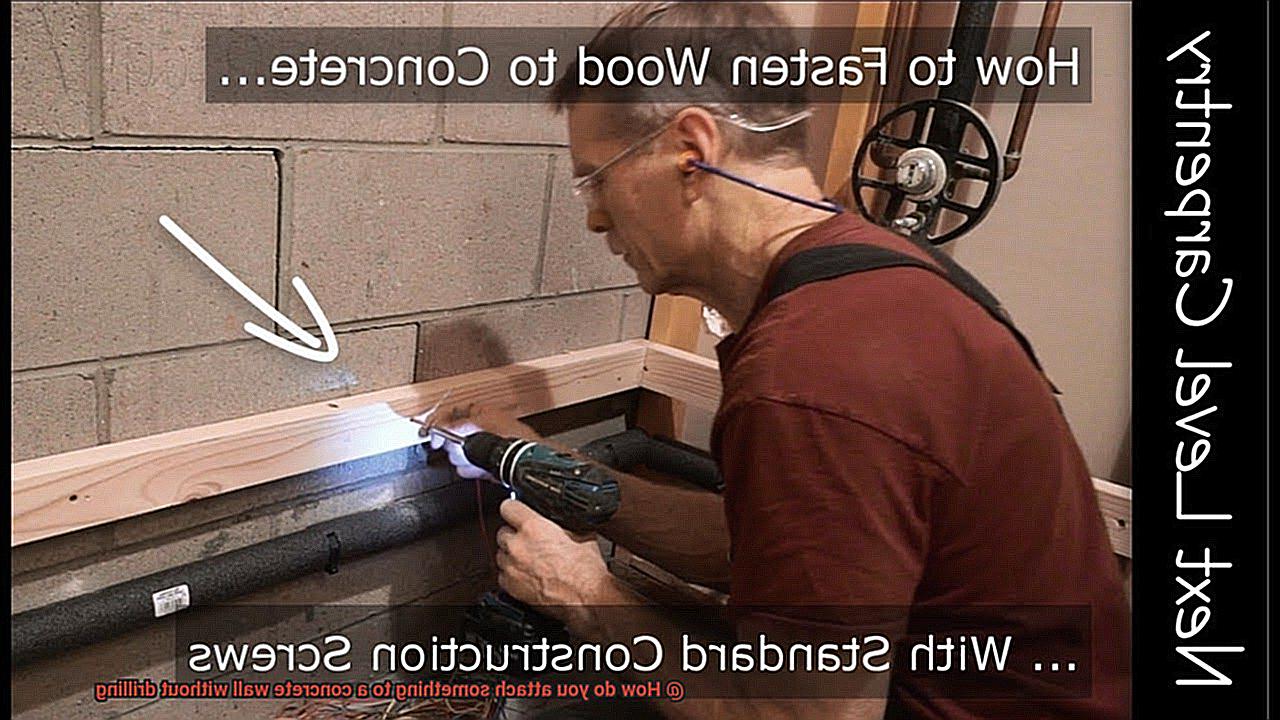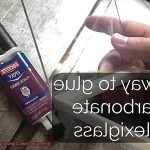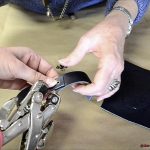Picture this – you’ve just moved into your dream apartment with stunning concrete walls, but now you’re faced with a dilemma. How do you hang things on these solid surfaces without drilling and causing permanent damage? Fear not, because we’ve got the perfect solution for you.
In this blog post, we’ll dive deep into the art of attaching objects to concrete walls without ever picking up a drill. Whether it’s a picture frame, shelf, or even a mirror, we’ll show you innovative techniques that will transform your space while keeping it intact.
With the rise of minimalist aesthetics, people are getting more cautious about drilling holes in their walls. Luckily, there’s an array of non-invasive alternatives that have emerged, offering versatile and practical solutions. Get ready to discover these game-changing methods that will ensure your concrete walls remain flawless.
The secret to attaching items without drilling lies in the power of adhesive hooks and tapes designed specifically for this purpose. But hold up – these aren’t your ordinary stickers or tapes. We’ll explore different types and their impressive load-bearing capacities, proving that even your heaviest artwork can find its perfect display spot without a single hole drilled.
But wait, there’s more. We’ll also take a journey into the fascinating world of magnetic mounting systems that tap into the hidden forces within your walls. These ingenious solutions provide easy-to-use options for securely attaching objects while preserving the elegance of your concrete wall.
So if you’re itching to adorn your concrete walls without leaving a trace behind, keep reading. We’ll be your guide through the captivating realm of non-destructive mounting options, equipping you with the knowledge to implement these techniques and transform your space without compromising its aesthetics or structure.
Adhesive Hooks
Contents
When it comes to adding a touch of personalization to your concrete walls without the hassle of drilling, adhesive hooks are the answer. These innovative hooks provide a secure and damage-free option for hanging lightweight objects. In this article, we will delve into the advantages and considerations of using adhesive hooks on concrete walls, offering practical tips for their effective use.
Advantages of Adhesive Hooks on Concrete Walls:
Effortless Installation:
No tools or special skills required. Installing adhesive hooks on concrete walls is a breeze. Simply peel off the protective backing from the adhesive strip and firmly press the hook onto the desired spot. It’s as easy as one, two, three. This user-friendly installation process makes adhesive hooks accessible to everyone, regardless of their DIY expertise.
Gentle Removal, No Residue:
Don’t worry about leaving a trace behind when removing adhesive hooks. Most manufacturers promise residue-free removal, ensuring that your concrete walls remain pristine. Follow the instructions provided by the manufacturer and gently peel off the hook while applying slight pressure on the wall with your other hand. Say goodbye to stubborn marks.
Versatility at Your Fingertips:
Adhesive hooks are incredibly versatile when it comes to hanging lightweight items. From small picture frames to decorative pieces, keys to clothing accessories like hats or scarves, these hooks can handle it all. Embrace your creativity and add functionality to your space without drilling a single hole.
Considerations when using Adhesive Hooks on Concrete Walls:
Respect Weight Limits:
To ensure optimal performance, always take note of the weight limit specified by the manufacturer for each adhesive hook. Overloading the hook beyond its capacity can compromise its adhesive strength, leading to unfortunate accidents with falling items. Check the packaging or product details to guarantee that you’re using the right hook for your intended item.
Surface Compatibility Matters:
While adhesive hooks excel on smooth concrete walls, textured finishes or uneven surfaces might pose a challenge. Before committing to hanging valuable or delicate items, test the adhesion in a discreet area. This simple precaution will help you determine if your specific wall surface provides an optimal bonding surface for the adhesive hooks.
Adhesive Tapes
Say goodbye to drilling and hello to the wonder of adhesive tapes. These little strips of stickiness are here to save the day, offering a hassle-free solution for attaching objects to concrete walls. But before you dive into this sticky world, let’s explore the different types of adhesive tapes available.
First up, we have the trusty double-sided foam tape. This magical tape is perfect for mounting lightweight objects like posters, picture frames, or small decorations. With adhesive on both sides and a foam backing, it provides an unbeatable bonding strength. The best part? It molds itself to the irregularities of your wall surface, ensuring a secure and long-lasting attachment. No more crooked frames or wobbly decor.
Now, let’s talk heavy-duty mounting tape. This bad boy is designed to hold heavier objects with its superior adhesive strength. If you’re looking to mount larger frames, mirrors, or even shelves onto your concrete walls, this tape is your new best friend. It’s thicker and stronger than regular foam tapes, providing reliable support for those weightier loads.
But wait, there’s more. Let’s not forget about specialized adhesive tapes. While not specifically designed for attaching objects to concrete walls, they can still get the job done depending on what you’re working with. Carpet tape and duct tape are two prime examples of these versatile tapes. Just keep in mind that they may not offer the same level of durability and long-term adhesion as double-sided foam or heavy-duty mounting tapes.
Before you go on your sticking spree, here are a couple of tips to remember. First and foremost, make sure your wall surface is squeaky clean and free from any dust or debris. This will ensure optimal adhesion and prevent any premature peeling incidents. Secondly, apply the tape directly onto the object you’re attaching rather than on the wall itself. This allows for easy adjustment and alignment before giving it a firm press against the wall. No more wonky artwork, folks.
Velcro Strips
Velcro strips are here to revolutionize your wall decor game. These ingenious fastening systems consist of two components: the hook side and the loop side, creating a bond that is as strong as it is convenient.
Let’s dive into the world of Velcro and explore the steps and benefits of using Velcro strips to attach items to your concrete walls.
Step 1: Clean, Clean, Clean.
Before you embark on your Velcro adventure, ensure that both your wall and the item you want to attach are squeaky clean. Dust and debris can hinder the adhesive’s effectiveness. Give them a good wipe-down with a cloth to create the perfect bonding surface.
Step 2: Cut and Prepare
Measure twice, cut once. Tailor your Velcro strips to fit the size and weight of your item. Whether it’s a petite picture frame or a sizable mirror, make sure you have the right length for optimal support.
Step 3: Stick it.
Peel off the backing from one side of the Velcro strip and firmly press it onto the back of your item. Apply even pressure to create a bond that won’t let go. Then, remove the backing from the other side of the Velcro strip and press it firmly onto your desired spot on the concrete wall. Remember, even pressure is key for maximum adhesion.
Step 4: Choose the Right Velcro
Not all Velcro strips are created equal, especially when it comes to rough surfaces like concrete walls. Look for heavy-duty or outdoor-grade Velcro strips specifically designed for challenging conditions. These high-quality strips boast a stronger adhesive that can stand up to any test.
Now that you know the steps, let’s explore the benefits of using Velcro strips on your concrete walls.
- Versatility: The beauty of Velcro strips lies in their versatility. They can effortlessly hold a wide array of items, from picture frames and mirrors to shelves and even lightweight furniture. Let your creativity run wild as you explore the endless possibilities for your wall decor.
- Ease of Installation and Removal: Say goodbye to invasive drilling and unsightly wall damage. Velcro strips offer a non-invasive solution that is both easy to install and remove. They leave no holes or marks behind, making them perfect for renters or those who love to rearrange their spaces frequently.
Adhesive Anchors
In this captivating exploration, we’ll uncover the wonders of adhesive anchors and how they effortlessly transform your living space. Let’s dive in and unlock the magic.
Ease of Installation: No Drilling Required.
Drilling? Who needs it. With adhesive anchors, installation is a breeze, even for those with basic DIY skills. Simply clean the wall’s surface, apply the adhesive, press firmly, and let it work its magic. The adhesive gradually cures, creating an unbreakable bond that securely holds your object in place.
The Perfect Adhesive Anchor: Selecting Your Superhero
When it comes to adhesive anchors, choosing the right one is crucial for success. Each adhesive type offers unique strengths and durability for specific needs. For heavy-duty applications, opt for epoxy-based adhesives known for their unmatched strength and durability. If you’re working with lighter objects or temporary installations, acrylic adhesives are your go-to heroes. To make the perfect choice, consult the manufacturer’s instructions or seek professional advice.
Cleanliness is Key: Preparing the Surface for Bonding
To ensure a rock-solid bond, cleanliness is key. Rid your concrete wall of any debris or contaminants that could sabotage the bonding process. A quick brush with a wire brush or sandpaper will do wonders by slightly roughening up the wall’s surface and enhancing the adhesive’s grip. This simple yet crucial step sets the stage for a secure bond that will stand the test of time.
Weight and Load Capacities: The Power of Consideration
Before attaching your object, take a moment to consider its weight and the potential load it may impose on the anchor. Adhesive anchors have specific weight limits and load capacities that must not be overlooked. Prioritize safety by checking the manufacturer’s instructions or consulting with professionals. By doing so, you can confidently enjoy your securely attached object without any worries.
Suction Cups
Say goodbye to the hassle and welcome the magic of suction cups. These ingenious devices utilize the power of suction to securely attach items to concrete walls without any drilling. Join me on a journey through the captivating world of suction cups as we explore their versatility and learn how to effortlessly transform your living space.
The Key to Success: Cleanliness is Paramount
Before embarking on your suction cup adventure, ensure that your concrete wall’s surface is spotless. Remove any dust or debris using a brush or sandpaper. This meticulous cleaning process enhances the grip of the suction cup, guaranteeing a strong bond that will stand the test of time.
Harness the Power of Moisture
To unlock maximum suction power, moisten the inner surface of the suction cup with water or an adhesive-friendly liquid. This simple step creates a formidable seal between the cup and the wall, minimizing the risk of losing grip over time. Remember, a touch of moisture can work wonders.
Press and Seal: A Dance of Precision
Now, let’s put your suction cup to work. Take a deep breath and firmly press it against the immaculate and moistened wall surface. Ensure that it is centered and aligned perfectly. Apply gentle pressure to compress the air inside the cup, unleashing its incredible suction power. Revel in that satisfying resistance and know that your suction cup is securely fastened, ready for the next step.
Hang with Confidence: Unleash Your Creativity
With your suction cup firmly attached to the wall, it’s time to showcase your artistic prowess. Utilize the hook or attachment mechanism on the other end of the suction cup to hang your desired item. Whether it’s a mesmerizing mirror, an elegant clock, or a breathtaking piece of artwork, let your creative spirit soar.
Ensuring Success: Considerations and Inspections
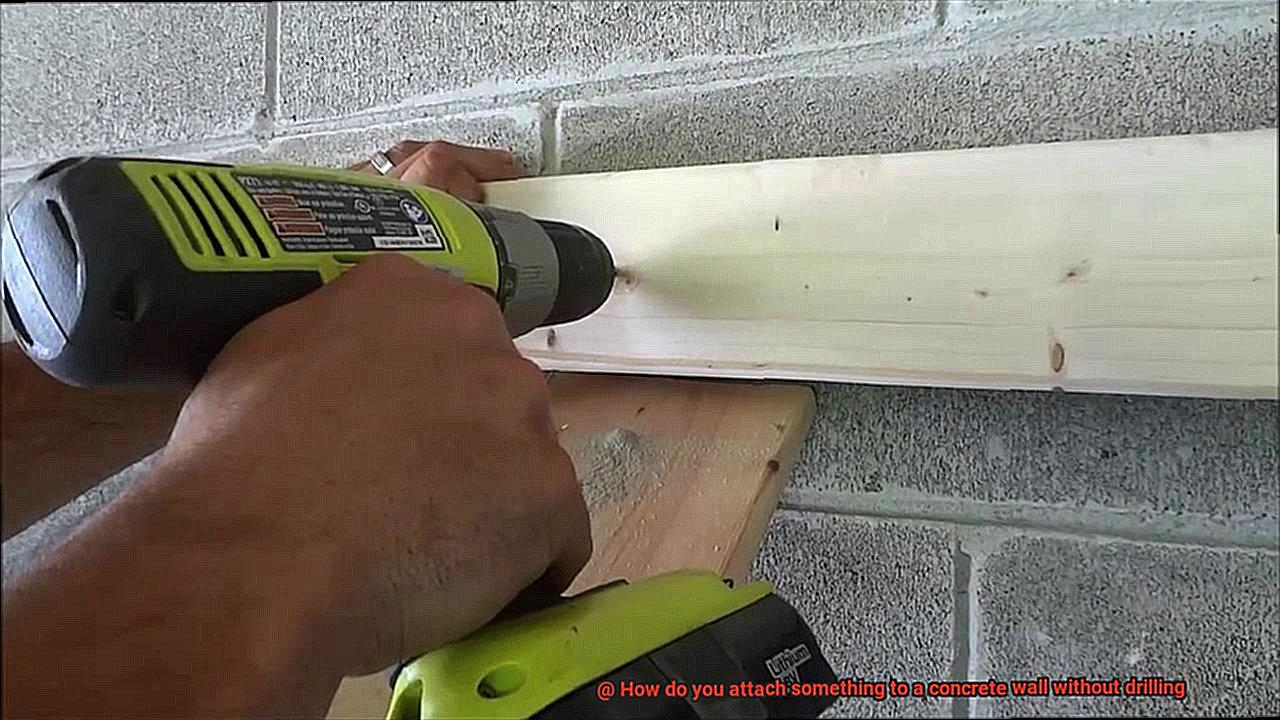
While suction cups possess inherent magic, a few considerations can guarantee a successful attachment. Smooth, non-porous surfaces are the ideal canvas for suction cups, so if your concrete wall has a rough texture or is porous, explore alternative options. Be mindful of extreme temperatures as they can impact suction cup performance. Avoid using them in scorching heat or freezing cold conditions to maintain their gripping power.
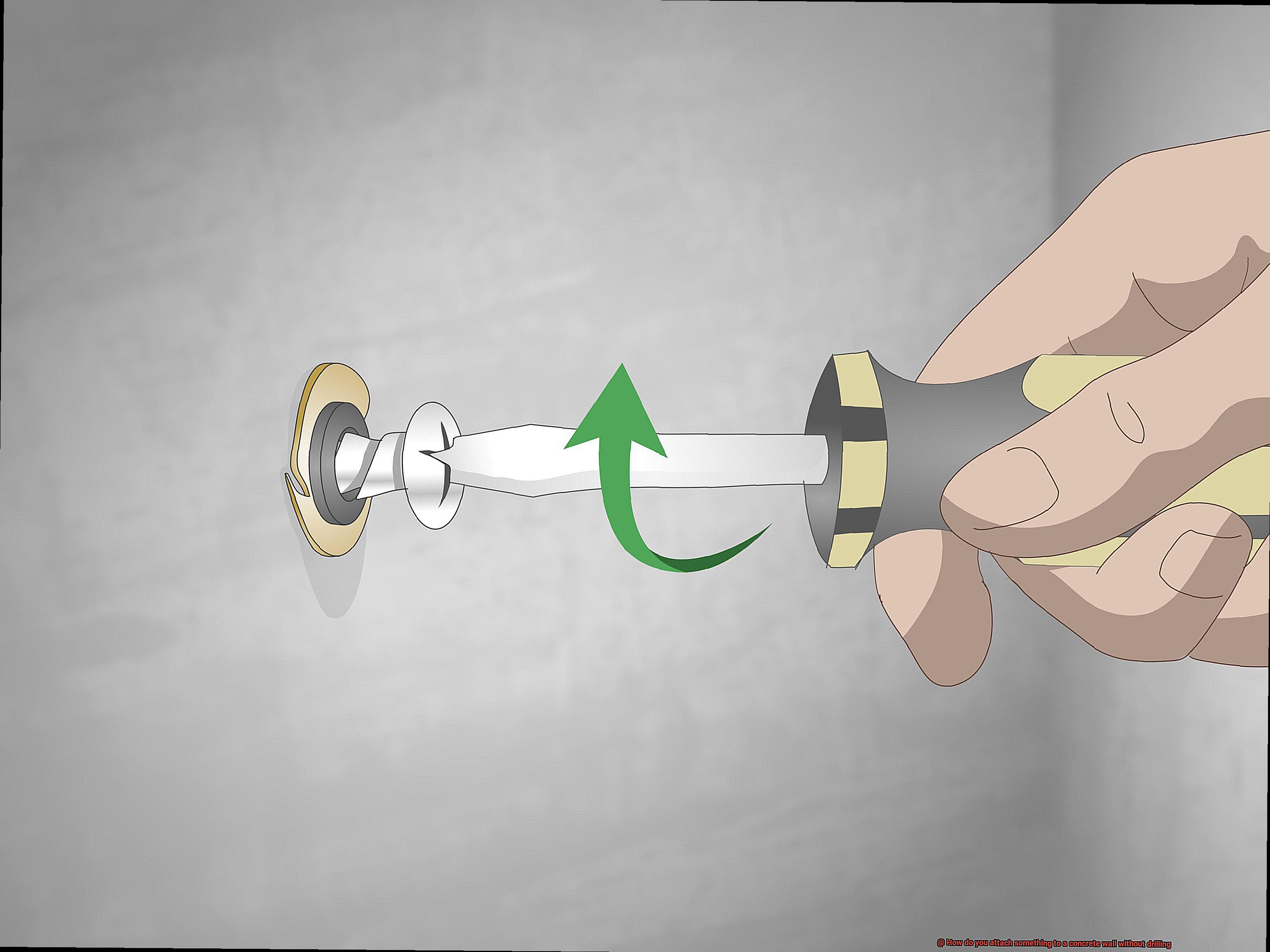
Specialized Adhesives
Prepare to be captivated by the mesmerizing world of specialized adhesives. These magical substances have transformed the way we attach objects to concrete, offering a secure and long-lasting bond without the need for drilling. Join us as we embark on a journey to explore the wonders of specialized adhesives.
Choosing the Perfect Adhesive:
Just like in any enchanting quest, selecting the right tool is crucial for success. When it comes to specialized adhesives for concrete walls, several factors must be considered. First, ponder upon the weight of the object you wish to attach. Each adhesive possesses its own weight capacity, ensuring you find one that can handle your load.
Next, consider the surface area of the attachment. If you’re dealing with large or irregularly shaped objects, selecting an adhesive with exceptional coverage is essential. Furthermore, take into account the environmental conditions your adhesive will face. Will it be exposed to extreme temperatures or high levels of moisture? Certain adhesives are specifically formulated to withstand these challenges.
Discovering the Hidden Gems: Types of Specialized Adhesives:
Now, let’s delve into the treasure trove of specialized adhesives themselves. The market offers a diverse array of options, each possessing unique properties and applications. Here are three noteworthy types:
- Epoxy Adhesives: Unleashing unparalleled bonding capabilities and resistance to high temperatures, epoxy adhesives reign supreme in heavy-duty applications. From attaching shelves to concrete walls to securing cabinets, these adhesives consist of two components that must be expertly mixed before application.
- Polyurethane Adhesives: Prepare to be amazed by the versatility and durability of polyurethane adhesives. With their exceptional flexibility, they are ideal for attaching lightweight objects or materials with different expansion rates, such as wood or plastic. Choose between one-component or two-component formulations based on your needs.
- Construction Adhesives: Crafted exclusively for bonding construction materials, including concrete, these adhesives are the unsung heroes of the trade. Embodying strength and resilience, they provide a steadfast bond even in the harshest conditions. Application is a breeze, with the option to utilize a caulk gun or adhesive gun for optimal precision.
Surface Preparation and Testing
Get ready to be enchanted as we delve into the captivating realm of surface preparation and testing when it comes to attaching something to a concrete wall without drilling. Prepare to witness the awe-inspiring power of proper preparation and unleash the magic of long-lasting, secure attachments. So grab your brooms, dust off your skepticism, and let’s embark on this thrilling journey together.
Cleanliness is Next to Stickiness:
Before we can weave our adhesive wonders, we must sweep away any doubts or uncertainties by ensuring the concrete wall is impeccably clean. Summon your wire brush, broom, or trusty vacuum cleaner, and bid farewell to the dust, dirt, and loose particles that dare to hinder our bonding process. Remember, a pristine surface is the secret to an unbreakable attachment.
Testing the Porosity:
Now it’s time to unveil our porosity test—a spell that reveals the true nature of our concrete wall. Sprinkle water upon its surface and watch closely as it performs its dance. Does it greedily absorb every drop within seconds? Ah, behold. We have a highly porous wall that craves a special adhesive or mounting solution tailored for porous surfaces. But if the water defiantly beads up and refuses absorption, rejoice. Our concrete wall is non-porous, calling for a different approach to work its magic.
Repairing Damages – The Wizard’s Touch:
No enchanting journey is complete without overcoming obstacles along the way. Inspect your concrete wall with a discerning eye, seeking out cracks, chips, or uneven surfaces that dare challenge our attachment dreams. But fret not. With a flick of our wand—a suitable patching compound—and the deftness of a skilled magician’s hand, we shall fill those cracks and smooth out the rough edges. Behold the transformation as our wall is restored to its former glory.
Considerations for Wall Types and Weights
We’ve uncovered the secrets to attaching items to concrete walls without drilling. In this article, we will delve into the key considerations for selecting the perfect adhesive or mounting system that will defy gravity and keep your belongings securely in place.
Solid Concrete Walls: Unyielding Titans
Solid concrete walls stand tall as the unyielding titans of the wall world. Their strength knows no bounds, making them capable of supporting heavy loads effortlessly. To conquer these mighty giants, arm yourself with a potent adhesive designed explicitly for concrete surfaces. Before applying the adhesive, ensure that the wall’s surface is pristine, free from any dust or debris that could undermine the bond.
Hollow Concrete Walls: Conquering the Abyss
Navigating the treacherous terrain of hollow concrete walls may seem like a daunting task. These walls contain hollow cavities that challenge your attachment ambitions. But fear not. Ingenious adhesive hooks or fasteners have emerged as your allies in this battle. Crafted specifically for hollow concrete walls, these hooks and fasteners possess special mechanisms that expand within the cavities, forming an unbreakable grip.
Concrete Block Walls: The Mortar Masterplan
Concrete block walls consist of individual blocks held together by mortar, presenting a unique puzzle to solve. When attaching something to these walls, uncovering the mortar joints is your key to success. These joints offer superior stability compared to the blocks themselves. By skillfully installing anchors or fasteners into the mortar joints, you ensure a secure attachment while minimizing damage to the blocks.
Reinforced Concrete Walls: Unlocking Fortresses
Reinforced concrete walls stand as impenetrable fortresses fortified with steel bars or mesh within their very structure. These walls are commonly found in grand commercial buildings and towering skyscrapers. To conquer these formidable opponents, seek the guidance of professionals or experienced contractors who possess the specialized techniques and equipment needed to safely and effectively attach objects to these walls.
Weight Matters: A Balancing Act
The weight and size of the object you wish to showcase on your concrete wall play a pivotal role in your attachment strategy. Heavier objects demand a robust adhesive or mounting system that can withstand their gravitational pull. Always adhere to the weight limits recommended by the manufacturer, ensuring a secure attachment that defies gravity’s relentless tug.
-v7FujAXg4Q” >
Conclusion
In conclusion, when it comes to attaching something to a concrete wall without drilling, there are several effective methods you can employ.
One option is using adhesive hooks or strips specifically designed for concrete surfaces. These hooks provide a strong and secure hold, making them ideal for hanging lightweight items such as pictures or small shelves.
Another alternative is utilizing concrete anchors, which are inserted into pre-drilled holes and expand within the concrete to create a firm grip. This method is more suitable for heavier objects like mirrors or cabinets.
Additionally, you can consider using construction adhesive, applying it directly to the back of your item before pressing it firmly against the wall. This technique ensures a durable bond but may require some caution when removing the item in the future.
Remember to clean the surface thoroughly before applying the suction cup for optimal adhesion.

